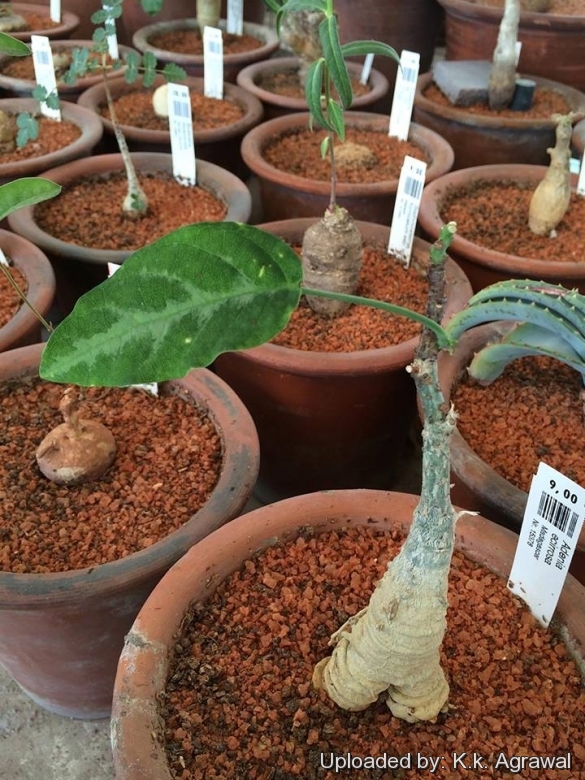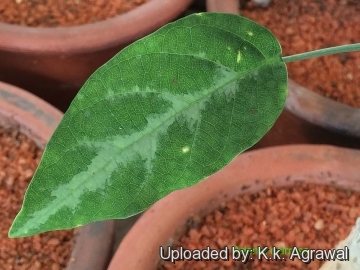




Your support is critical to our success.

Origin and Habitat: Adenia ecirrosaSN|29805]]SN|29805]] is endemic to Madagascar (Type locality West. (South), Betioky Distr. SW. of Lac Manampetsa)
Habitat and ecology: It grows at low altitudes in dry thicket vegetation.
Synonyms:
- Adenia ecirrosa W.J.de Wilde
JAPANESE (日本語): アデニア・エキロッサ
Description: Adenia ecirrosa is a monoecious erect shrub up to about 2-3 m high with shoots growing from a slightly thickened main stem.
Stems: Main stem slightly thickened, branches few, without tendrils. Internodes 1-5 cm. Fertile branches 2-3 mm long.
Leaves: Entire to mostly deeply palmately 3(–5)-lobed, roundish in outline, cordate at the base, 4-9 cm long 4-8 cm wide, with 3–5 main nerves from the base, reticulation fine, distinct. Margin variously dentate or dissected, membranous to subcoriaceous, brownish-green above, much paler or grey-green beneath, not punctate. Lobes ovate-elliptic, entire or once more deeply 3-7-lobed top obtuse to acute-acuminate. Petiole 1–7 cm long. Glands at base of blade 2, mostly at each side of petiole. Glands 2, about 2 mm thick at the transition of blade and petiole. Stipules narrowly triangular, acute or subulate, 0.5-1 mm long. Juvenile leaf entire lanceolate peltate.
Inflorescences: 1–5-flowered in male plants, peduncle up to 5 mm long without tendrils. Bracts and bracteoles lanceolate to linear, acute, 2-4 mm long.
Male flowers: Tubular to funnelshaped, 19-20 mm long, 2 mm in diameter (including stipe c. 5 mm long). Pedicel 0-1 mm. Sepals recurved in anthesis, about 15 mm wide. Hypanthium tubular about 6 mm long, gradually passing into the stipe, tube about 1 mm in diameter. Calyx-lobes 7-8 mm long, c. 5 wide oblong, obtuse, subentire more or less recurved. Petals oblong-lanceolate, 5 mm long, 2 mm wide recurved in the upper half. Filaments 2 mm long, inserted about 2 mm below the throat of the hypanthium. Anthers 5 mm long 2/3 mm wide, obtuse. Corona and disk glands absent.
Female flowers: Not known.
Blooming season: Flowers in spring ( in habitat October)
Fruit: Not known
Related species: It is related to Adenia perrieri, Adenia monadelpha, Adenia epigea, Adenia refracta, and Adenia peltata. It differs from the latter two species by the position of the basal blade glands, and from the other three species by various leaf- and flower characters. The species is apparently most related to the sympatric A. monadelpha, but differs by the erect habit and the absence of tendrils.
Bibliography: Major references and further lectures
1) "Adenia ecirrosa" in : Belmontia: Miscellaneous Publications in Botany. Taxonomy, Eds 10-14 Laboratory of Plant Taxonomy and Geography, University for Agriculture., 1969
2) W.J.De Wilde “A monograph of the genus Adenia Forsk. (Passifloraceae)” Meded. Landbouwhogeschool Wageningen 71-18 1971

Beautiful juvenile leaf of Adenia ecirrosa Photo by: K.k. Agrawal
The gallery now contains thousands of pictures, however it is possible to do even more. We are, of course, seeking photos of species not yet shown in the gallery but not only that, we are also looking for better pictures than those already present. Read More...
Cultivation and Propagation: Adenia ellenbeckiiSN|29169]]SN|29169]] is an interesting addition to a collection, but rarely seen in cultivation. It can be grown outdoors in frost-free climates and forms an impenetrable shrub if not manicured.
Growth rate: It grows well, though very slowly, but it possible to increase the speed of growth to some extent by providing adequate amount of water, warmth, and fertilizer during the active growing season, but it’s susceptible to rotting if too wet.
Exposure: It needs light shad. Avoid direct blasting sun in summer. Bright light if grown indoors.
Soil: In pots it needs a very porous potting medium (add pumice, vulcanite, and perlite). It does better in a rather acidic soil.
Waterings: Water frequently while plant is in full growth, but keep dry during the winter. It rot easily and do NOT like a lot of water when it has no leaves.
Fertilizer: Benefits from moderate doses of a well-balanced, slow-release fertilizer.
Frost tolerance: Due to its African origin keep warm in winter, the minimum safe average temperature is 15°C, although it can go lower for short periods. It can be grown outdoors in frost-free climates, need anyway to kept above 10°C and dry in winter. It is very prone to rot in cool, wet conditions. USDA Zone 10-12, but does very well in containers.
Manteinance: Repot every two years. It like pots with generous drain holes. In the winter, the vining branches die back and should be cut back t to encourage branching, to maintain an attractive shape and to ensure caudex habit. If pruned and kept somewhat pot bound, it can be maintained at a manageable size, depending on what ''manageable size'' means to you.
Propagation: The species can be propagated by both seeds and cuttings. The plants for seed production are generally grown from cuttings since these bloom more freely. The plants for decoration are grown from seed since they develop a caudex.
Warning: As with all Adenias, all parts of this plant are very toxic, and they should be handled with caution, particularly when pruning.
| Your Actions | |
|---|---|
| Back to Adenia index | |
| Back to Passifloraceae index | |
 |
Back to Succulents Encyclopedia index |
Privacy stantement - Terms and conditions - How to cite - About us - Feedback - Donate



